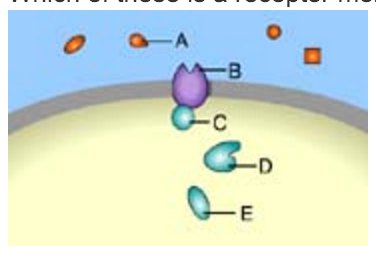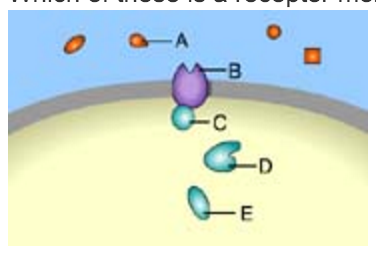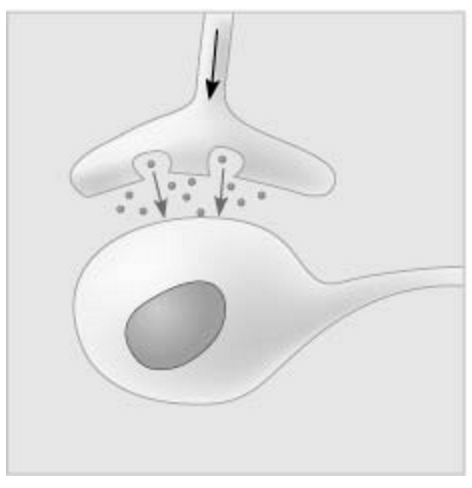
Which of these is a receptor molecule?
A. A
B. B
C. C
D. D
E. E
B.
A signal transduction pathway is initiated when a _____ binds to a receptor.
A. cyclic AMP
B. signal molecule
C. tyrosine kinase
D. calmodulin
E. G protein
B. signal molecule
The binding of a signal molecule to a receptor initiates a signal transduction pathway.

Which of these is a signal molecule?
A. A
B. B
C. C
D. D
E. E
A.
A signal molecule is also known as a(n) _____.
A. protein
B. receptor
C. ligand
D. initiator
E. key
C. ligand
A ligand is a signal molecule.
Which of these is the second of the three stages of cell signaling?
A. gene activation
B. reception
C. binding of a neurotransmitter to a plasma membrane receptor
D. transduction
E. cell response
D. transduction
Transduction is the second of the three stages of cell signaling.
Which of the following provides molecular evidence that signal transduction pathways evolved early in the history of life?
A. Simple forms of life, such as prokaryotic cells, utilize cell signaling.
B. The molecular details of cell signaling are quite similar in organisms whose last common ancestor was a billion years ago.
C. Receptor molecules have been identified in preparations of fossilized organisms billions of years old.
D. The pathways in primitive organisms, such as bacteria, are short, whereas those in advanced forms, such as mammals, are long.
E. Cell signaling is observed in organisms that do not utilize sexual reproduction.
B. The molecular details of cell signaling are quite similar in organisms whose last common ancestor was a billion years ago.
Yeast and mammal cells, for example, are very distantly related yet share many similarities in cell signaling.
Which of the following is a substance that acts at a long distance from the site at which it is secreted?
A. synaptic signal
B. neurotransmitter
C. local regulator
D. paracrine signal
E. hormone
E. hormone
Both animals and plants use hormones for signaling at greater distances.

Which of the following types of signaling is represented in the figure?
A. hormonal
B. paracrine
C. synaptic
D. autocrine
C. synaptic
To what does the term "ligand" refer in cell biology?
A. the change in shape that occurs when a signaling molecule binds to its receptor
B. any small molecule that can bind in a specific manner to a larger one
C. the bond that forms between a signaling molecule and its receptor
D. the target cell of a signal molecule
E. a molecule that can occupy a receptor site while not activating the receptor
B. any small molecule that can bind in a specific manner to a larger one
Ligands are the small signaling molecules that bind specifically to corresponding protein-receptor molecules.
A G-protein receptor with GTP bound to it _____.
A. will use cGMP as a second messenger
B. is in its active state
C. directly affects gene expression
D. signals a protein to maintain its shape and conformation
B. is in its active state
If an animal cell suddenly lost the ability to produce GTP, what might happen to its signaling system?
A. It would be able to carry out reception and transduction but would not be able to respond to a signal.
B. It would use ATP instead of GTP to activate and inactivate the G protein on the cytoplasmic side of the plasma membrane.
C. It would not be able to activate and inactivate the G protein on the cytoplasmic side of the plasma membrane.
D. It would employ a transduction pathway directly from an external messenger.
C. It would not be able to activate and inactivate the G protein on the cytoplasmic side of the plasma membrane.
Not all intercellular signals require transduction. Which one of the following signals would be processed without transduction?
A. a signal that binds to the ECM
B. a signal that binds to a receptor in the cell membrane
C. a lipid-soluble signal
D. a signal that is weakly bound to a nucleotide
C. a lipid-soluble signal
Which of the following are among the most common second messengers?
A. G proteins and GTP
B. calcium ion and cAMP
C. kinase and phosphate groups
D. GTP and GDP
E. kinase and phosphatase
B. calcium ion and cAMP
These are the most commonly observed second messengers.
In general, a signal transmitted via phosphorylation of a series of proteins _____.
A. generates ATP in the process of signal transduction
B. activates a transcription event
C. results in a conformational change to each protein
D. requires binding of a hormone to an intracellular receptor
C. results in a conformational change to each protein
An inhibitor of which of the following could be used to block the release of calcium from the endoplasmic reticulum?
A. phospholipase C
B. phosphodiesterase
C. adenylyl cyclase
D. serine/threonine kinases
A. phospholipase C
Protein kinase is an enzyme that _____.
A. functions as a second messenger molecule
B. activates or inactivates other proteins by adding a phosphate group to them
C. produces second messenger molecules
D. serves as a receptor for various signal molecules
B. activates or inactivates other proteins by adding a phosphate group to them
Consider this pathway: epinephrine → G protein-coupled receptor → G protein → adenylyl cyclase → cAMP. The second messenger in this pathway is _____.
A. G protein-coupled receptor
B. cAMP
C. adenylyl cyclase
D. G protein
B. cAMP
Which of the following is true during a typical cAMP-type signal transduction event?
A. Adenylyl cyclase is activated after the hormone binds to the cell and before phosphorylation of proteins occurs.
B. The second messenger is the last part of the system to be activated.
C. The second messenger amplifies the hormonal response by attracting more hormones to the cell being affected.
D. The hormone activates the second messenger by directly binding to it.
A. Adenylyl cyclase is activated after the hormone binds to the cell and before phosphorylation of proteins occurs.
Put the steps of the process of signal transduction in the order they
occur:
1. A conformational change in the signal-receptor complex
activates an enzyme.
2. Protein kinases are activated.
3. A
signal molecule binds to a receptor.
4. Target proteins are
phosphorylated.
5. Second messenger molecules are released.
A. 1, 2, 5, 3, 4
B. 3, 1, 2, 4, 5
C. 1, 2, 3, 4, 5
D. 3, 1, 5, 2, 4
D. 3, 1, 5, 2, 4
The cleavage of glycogen by glycogen phosphorylase releases _____.
A. glucose-1-phosphate
B. fructose-1-phosphate
C. galactose-1-phosphate
D. cellulose
E. nothing: glycogen phosphorylase cannot cleave glycogen
A. glucose-1-phosphate
Glycogen is a polysaccharide composed of glucose monomers.
Epinephrine acts as a signal molecule that attaches to _____ proteins.
A. nuclear receptor
B. intracellular receptorion-channel receptor
C. G-protein-linked receptor
D. receptor tyrosine kinase
C. G-protein-linked receptor
Epinephrine acts via G-protein-linked receptors.
Which of these is activated by calcium ions?
A. PIP2
B. calmodulin
C. adenylyl cyclase
D. IP3
E. G protein
B. calmodulin
Calmodulin is a calcium-binding protein.
Which of these is NOT correct?
A. Kinases are enzymes that phosphorylate other molecules.
B. Ion channels are found on both the plasma membrane and the endoplasmic reticulum.
C. Cyclic AMP binds to calmodulin.
D. Tyrosine-kinase receptors consist of two polypeptides that join when activated by a signal molecule.
E. Phospholipase C catalyzes the formation of IP3.
C. Cyclic AMP binds to calmodulin.
Calcium binds to calmodulin.
A toxin that inhibits the production of GTP would interfere with the function of a signal transduction pathway that is initiated by the binding of a signal molecule to _____ receptors.
A. ion-channel
B. receptor tyrosine kinase
C. intracellular
D. G-protein-linked
E. steroid
D. G-protein-linked
GTP activates G proteins.
Why can a signaling molecule cause different responses in different cells?
A. The transduction pathway in cells has a variable length.
B. The transduction process is unique to each cell type; to respond to a signal, different cells require only a similar membrane receptor.
C. Different cells possess different enzymes, which modify the signaling molecule into different molecules after it has arrived.
D. Different cells have membrane receptors that bind to different sides of the signaling molecule.All of the above are correct.
B. The transduction process is unique to each cell type; to respond to a signal, different cells require only a similar membrane receptor.
The signal simply initiates a process by activating a membrane receptor. How transduction proceeds can be quite different for different cells.
Transcription factors _____.
A. regulate the synthesis of lipids in the cytoplasm
B. control gene expression
C. transcribe ATP into cAMP
D. regulate the synthesis of DNA in response to a signal
B. control gene expression
Scaffolding proteins are _____.
A. microtubular protein arrays that allow lipid-soluble hormones to get from the cell membrane to the nuclear pores
B. relay proteins that orient receptors and their ligands in appropriate directions to facilitate their complexing
C. proteins that can reach into the nucleus of a cell to affect transcription
D. large molecules to which several relay proteins attach to facilitate cascade effects
D. large molecules to which several relay proteins attach to facilitate cascade effects
Phosphorylation cascades involving a series of protein kinases are useful for cellular signal transduction because they _____.
A. are species specific
B. always lead to the same cellular response
C. amplify the original signal many times
D. counter the harmful effects of phosphatases
C. amplify the original signal many times
What is apoptosis?
A. a way to stimulate transcription
B. a type of second messenger
C. controlled cell suicide
D. a metabolic step in blood clotting
E. a type of membrane receptor
C. controlled cell suicide
If an adult person has a faulty version of the human analog to ced-4 of the nematode, which of the following is most likely to result?
A. excess skin loss
B. a form of cancer in which there is insufficient apoptosis
C. formation of molecular pores in the mitochondrial outer membrane
D. activation of a developmental pathway found in the worm but not in humans
B. a form of cancer in which there is insufficient apoptosis
In the nematode C. elegans, ced-9 prevents apoptosis in a normal cell in which of the following ways?
A. It prevents the caspase activity of ced-3 and ced-4.
B. Ced-9 remains inactive until it is signaled by ced-3 and other caspases.
C. Ced-9 cleaves to produce ced-3 and ced-4.
D. Ced-9 prevents blebbing by its action on the cell membrane.
A. It prevents the caspase activity of ced-3 and ced-4.